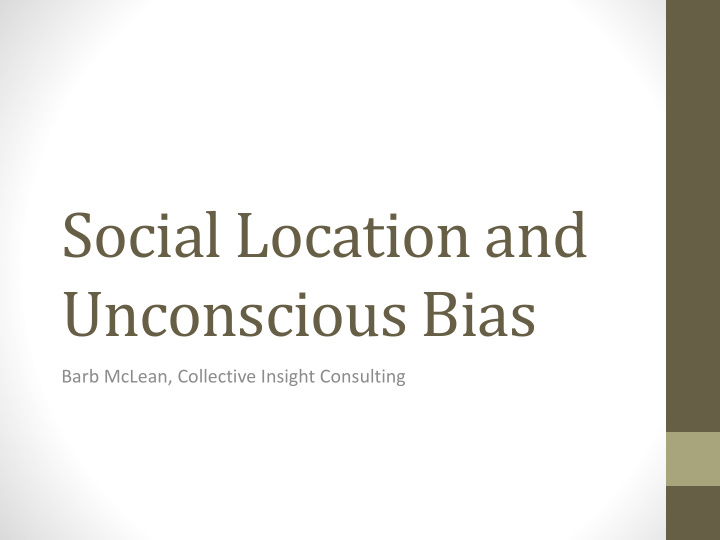



Social Location and Unconscious Bias Barb McLean, Collective Insight Consulting
Honouring the Traditional Territory
Session Agreements • Actively engage in discussions in the spirit of respect • Confidentiality : what’s shared in the room stays in the room • Be open to differing ideas and priorities • Avoid interrupting each other • Seek clarification through inquiry, not debate • Listen as an ally • It’s OK to share alternative perspectives • It’s also OK to have some FUN
Activity: What is your social location?
Social Location – Your place in space • Self-awareness • Perceive a situation • Personal philosophy • It impacts how you see/sense the world • Decisions you make
Race *Political Colour Belief Age Ancestry Sexual Place of Orientation Origin Protected Source of Religious Income Beliefs Grounds Family Gender Status Identity Marital Gender Status Expression Mental Gender Disability Physical Disability
Brain Function
Social Categorization
Conditioning WHITE
Dangers of categorization and conditioning • Can lead to stereotyping • Can lead to prejudice • Can lead to “unintentional incivility” or “micro -inequities ” • Can lead to preferring people who are “like us” • Information that goes against the categorization are seen as anomalies
Unconscious Bias Bias in its simplest terms is a preference. A cause to feel or show inclination or prejudice for or against someone or something. Bias is a tendency to believe that some people, ideas are better than others that usually results in treating some people unfairly. Unconscious Bias: Automatically triggered responses outside of our control or awareness (Greenwald & Banaji, 1995). Bias can be both preferences (providing favourable treatment) and prejudices (providing unfavourable treatment).
Unconscious Bias
Intent vs. Impact Golden Rule: Treat others as I would like to be treated Platinum Rule: Treat others as they would like to be treated
What action can I take? Four main types of actions: 1. Find out more about yourself 2. Immerse yourself in more diversity 3. Treat people as individuals 4. Create systems that account for bias
Find out more about yourself • Everyone has bias, become aware of your own • Recognize and be particularly vigilant in situations where your own biases will likely be most active such as when you are teaching • Challenge the “Gut feel” • Take the Implicit Association Test (IAT)
Implicit Association Test (IAT) • Developed at Harvard University • Developed originally as a device for exploring the unconscious roots of thinking and feeling • The IAT is now offered as a tool to gain greater awareness about the users own unconscious preferences and beliefs • https://implicit.harvard.edu/implicit/canada/
Immerse yourself in more diversity • Expose yourself to positive images or stories, particularly about those you work with • Actively seek out new experiences, visit new places and interact with a variety of people. • Have diverse mentors and mentees • Take workshops/courses/etc to further your understanding of marginalized groups
Treat people as individuals • Be aware when someone is in your “in group” or in an “out group” • Find out more about your colleagues and/or clients • Use active listening skills • Ensure everyone gets a chance to speak and that no one is dominating in meetings and discussions • Lessen your reliance on stereotypes and assumptions
Create systems that help account for bias • Recognize and be particularly vigilant in situations when you have incomplete information or are being rushed to make a decision • Create clear decision making mechanisms • Include multiple perspectives when making decisions • Apply an inclusion lens to your work and research
Ensure your classroom is welcoming and respectful • Ensure all voices are heard and that no one is dominating discussion • If you are creating a curriculum or syllabus, ensure you have a diverse offering of readings/teachings and diverse content • Ensure that respectful behaviour is discussed and understood and any disrespectful behaviour is addressed
Scenario 1 An Indigenous grad student is presenting their project to the class. While their project is met with positive feedback, a member of the class says : “You’re so well -spoken and professional, unlike others like you.”
Scenario 2 You have one very quiet student in your class. Since they never engage in class discussion, and never ask any questions, you assume they are not understanding the material. You make a note to yourself to watch for their assignments.
Further Resources Ted Talk – Are you biased? I am. • https://www.youtube.com/watch?time_continue=168&v=Bq_ xYSOZrgU The Royal Society – Understanding Unconscious Bias • https://www.youtube.com/watch?v=dVp9Z5k0dEE Life at Google – Unconscious Bias @ Work • https://www.youtube.com/watch?v=NW5s_-Nl3JE
Recommend
More recommend